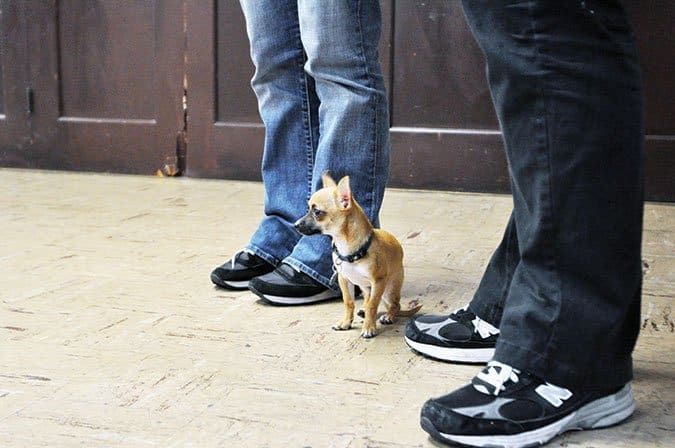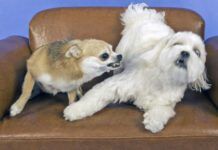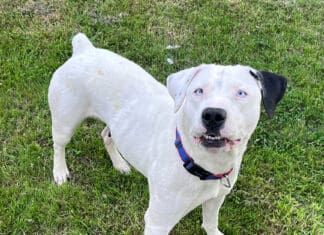Group training classes are a mixed bag of pros and cons. And I say this as someone who has made a fair amount of my annual income by teaching group training classes. I also attend group classes with my own dog.
The most obvious “pro” is the cost. In a group training situation, the economic cost is leveraged, allowing each student to pay less per hour compared to private instruction. It’s next to impossible to maintain a training facility without offering some group classes.
“The trade-off is that both humans and dogs are trying to learn new information in the worst possible situation,” says Hannah Branigan of Wonderpups dog training in Raleigh, North Carolina, and host of the popular training podcast, “Drinking From the Toilet.” “We always tell people we want them to train the dog in a low-distraction environment, and then, look how we teach them to do that!”
Some dogs are better able to withstand this challenge than others.
By design, the “ideal candidate” for a positive-reinforcement group manners class is the generally happy-go-lucky, emotionally stable, food-oriented dog whose worse transgression is maybe a minor lack of impulse control, simply because he hasn’t yet been taught how to do better – that’s why he’s there.
But in the real world, owners with dogs representing a wide range of temperaments and behavioral challenges find their way to group classes looking for help. Some dogs are fearful and hide under the chair. Some are fearful and reactive. Some are frustrated-greeter types and vocalize their frustration, loudly and persistently.

Making Group Class Work for Your Dog
Most of the time, each of these types of dogs can be successfully accommodated in a group class, but doing so requires careful management on the part of the instructor, to adjust the class environment and tailor individual exercises accordingly. For the owner, it means letting go of expectations and learning how to recognize the small victories for her own dog, even when those victories don’t look anything like what’s happening with other dog-and-handler teams.
Skilled instructors will be well-equipped to support these teams in ways that decrease distress and make it easier for all the dogs in class to succeed. Increasing distance from whatever is causing a fearful dog to react (whether it’s the unknown dogs or unknown people), and/or implementing visual barriers are two great strategies that help create an environment where an anxious dog can begin to relax.
Working Alone in a Group Setting
When people enroll in a basic obedience or “manners” class, they usually expect to work on skills: sit, down, stay, come-when-called, etc. But if their dog is challenged by the environment or concerned about or overexcited by some facet of his surroundings, that must be dealt with first.
It can be frustrating for the owner who really wants to start teaching those basic skills to her dog to have to delay that process for weeks – in class, at least. But consider that we, too, would find it difficult to concentrate on, say, learning a foreign language if we were also worried about reports of an escaped axe-murderer in our neighborhood, or while gushing with excitement over meeting our favorite celebrity crush. Before we were able to start conjugating verbs, we’d need time to feel safe, or for our head to come down from the clouds. We’d want our instructor to be patient and give us time, and/or help us recalibrate our emotions. Our dogs are the same!
Realistically, this might mean shifting your focus from basic skills, such a “sit” or “down,” to heavily reinforcing quiet behavior in your reactive dog via a rapid-fire string of high-value treats, or calmly rewarding the bolder moves of your fearful dog under your chair. When you’ve come to class expecting to work on “sit,” “down,” and “come,” it can be difficult to suddenly change your priorities, even when doing so is in the best interest of the dog. This is especially true when it seems like, compared to students working on skills, you aren’t “doing anything.”
In my experience, this often leads to owners trying even harder to get their dogs to engage in whatever skills exercise is taking place in class, often reaching for “bigger and better treats” in hopes of sustaining their dog’s attention long enough to lure him into position. Here’s the problem with that:
While it’s true that successful food-based dog training requires using food that’s of significant value to the learner, constantly trying to “up the ante” often means we’re asking the dog to do something he’s not yet able to handle. When the dog is struggling to “sit” because he’s feeling unsafe in the environment, or can’t “lie down” because he’s too over-stimulated by the other dogs, improving his emotional state is more important than squeaking out a half-hearted “sit” or “down” for the sake of keeping up with the rest of the class. Listen to your dog – he will tell you what he needs the most in the moment. You’re in class to help your dog, not to keep up with the Joneses. Once your dog’s emotional state improves, the basic skills behaviors will come.
Trying to Keep Up in Class
Trying too hard to “keep up” can actually cause more harm than good.
“My concern is, if we’re leading dogs around with food, we might accidentally lead them outside of their comfort zone,” says Branigan. Just because a dog is eating, she says, doesn’t mean he’s comfortable, and it’s easy to accidentally lead a dog beyond where he’d choose to go if not for the cookie in front of his nose.
The danger of this inadvertent over-facing is that the dog may be suddenly pushed over his personal coping threshold; he may become reactive, overly excited, or shut down completely, depending on his unique emotional and behavioral challenges. When training, it’s always better to set dogs up for success via a series of baby steps, i.e., to systematically teach them how to swim before letting them fall (or throwing them) into the pool!
“Getting a dog through a training class with a piece of hot dog on his nose does little to help solidify the skills he’ll need at home when, say, a baby is on the way,” adds Branigan. “We’re increasing his ability to follow food in a specific context, but that doesn’t necessarily carry over into real-life situations. Be careful not to mistake a dog’s ability to perform correctly in the presence of food with a solid understanding of the behavior.” (For more on this, see “Fluency and Generalization in Dog Training“.)
To be fair, it’s hard to be in a group situation and watch other teams appear to have more success while your dog sits cautiously under the chair, or while you concentrate on rewarding an absence of barking as other teams mingle about.
“It feels horrible!” says Branigan, “so people feel like they have to do something. Most of us have that bias toward action. We say, ‘This is uncomfortable and embarrassing; I need to do something to change this.’ But, in our desperate attempt to feel better, we put our long-term training goals at risk by potentially over-facing our dogs or tricking ourselves into believing our dog is learning an obedience skill when he’s really just half-heartedly following food.”
What to Expect from Group Dog Training Instruction
As a trainer, I know it’s likely that the “shy” puppy sitting under the chair will come around if given the opportunity to learn he is safe. I also know that the “reactive” dog is capable of learning how not reacting in the presence of his triggers will “pay” really well, especially when we pair well-timed reinforcement with a little environmental support, such as increased distance and visual barriers.
This can be harder for pet owners to understand, especially if it’s their first dog, or their first “challenging” dog. Branigan says it’s helpful for trainers to let clients know what to expect ahead of time, before they’re in the heat of the moment and potentially feeling embarrassed or frustrated.
“It’s ideal if clients head into the class situation knowing there’s a chance their dog won’t be able to focus and take food, or there’s a chance he might sit under the chair, but also knowing the trainer has seen that before. If they have been prepared and understand that the trainer knows what’s going on, and she has contingency plans for their type of dog already built into the class, it helps take the emotion out of it, and helps people make better choices while training,” Branigan says.
Be realistic about what might happen. If your dog excitedly barks when he sees other dogs on a walk, there’s a good chance he’s going to bark when he sees six other dogs in a crowded classroom. If your dog is shy when meeting new people, suddenly finding himself in a room full of strangers might be overwhelming. Even if he’s a happy-go-lucky hound, sometimes dogs surprise – and even embarrass us – in a group setting. Remember, it’s all okay! That’s why you’re there – to learn how to best help your dog!
No One in Class is Judging You
As a trainer, I know that all of these types of dogs are more than capable of learning how to sit, lie down, stay, and come-when-called if we present the lessons in a less-challenging environment. If your dog’s biggest challenge is coping with the group environment, with the help of the instructor, use class time to teach your dog how to feel better about being in a group. That victory is just as great – if not greater – than a sit, down, or stay for a dog who doesn’t struggle with the environment.
You can also use the time to focus on your handler skills using an imaginary dog as your dog quietly enjoys a food-stuffed Kong toy while safely tucked behind a visual barrier. Often, this is much easier than trying to refine your handling skills while simultaneously wrangling a reactive dog! All this handling practice more than pays off when it comes time to practice at home, where your dog is most comfortable and will likely be able to succeed in learning his lessons in the absence of all the class distractions.
Important in Sport-Dog Classes, Too!
While this article primarily focuses on traditional “manners” classes, the same considerations apply when participating in a sport-dog class, such as agility, rally, flyball, or competition obedience. We asked several dog-sport enthusiasts to share how they make group classes work for them:
“When I was taking my dog to agility class, something scary (in his mind) happened one day, and he couldn’t emotionally handle an entire class session anymore. We started participating in just half of the class, and spent the rest of the time playing fun games and working on desensitizing him to scary noises. It worked really well. It was great of the instructor to suggest this, rather than having to drop the class.”
– Beth O., California
“I did a novice obedience ring-readiness class with my Whippet, who, at the time, basically knew sit, down, and loose-leash walking. I told the instructor ahead of time that my main goal was to get her comfortable working around distractions. While other students worked on traditional competition heeling patterns, we did the same pattern, but with loose-leash walking. The class was great for helping her become comfortable at the training club and around other dogs, and we picked up a few obedience tips at the same time.”
– Wendy M., Florida
“My dog struggles with focus around distractions. He wants to look at and sniff everything around him. We’ve taken multiple group classes where we sit in the back and I reward every time he offers a moment of focus. Sometimes we have really good days. On those days, we participate in what the group is doing. Other days it’s too hard for him to focus on what I’m asking him to do, so we quietly concentrate on our focus games instead.”
– Asha M., Delaware
“My dog is shy around people, and we’re in a group rally class. There are often several people up working at once. The instructors are mindful of where people are situated, and they’re also fine with me doing whatever my dog is comfortable with that day. I enjoy being able to see how other students perform the signs, and I pick up training tips I can use when we practice at home.”
– Rachel O., Hampshire, U.K.
There are plenty of ways to modify participation in a group class so that it works better for your dog. Just be sure to communicate with the instructor about your needs, and make sure your alternative plans don’t negatively impact other working teams.
Dog Training is a Journey, Not A Race
Sometimes, it really is a better choice to withdraw from the group class in favor of working privately with the instructor in a less-distracting environment, or to attend the class without the dog to focus on your handling skills without over-facing your dog. Should this happen, it’s important to not feel like your dog “flunked out” of school!
What matters most is finding ways to support your dog as you work toward your long-term training goals, not pushing yourselves to fit in or keep up with a group. Not every training situation is right for every dog at every point of his training journey – and that’s okay. What’s important is finding what works best for you and your dog as a team.
TRAINING CLASS TROUBLES: OVERVIEW
1. Don’t feel pressured to “keep up” with the group. Listen to your dog. He will tell you what he needs most in the moment. Honoring this will support your long-term training goals.
2. Recognize and celebrate your successes!
3. Be realistic about your dog’s needs. Some dogs benefit more from private or semi-private lessons, depending on their needs.
Stephanie Colman is a writer and dog trainer in Southern California.




